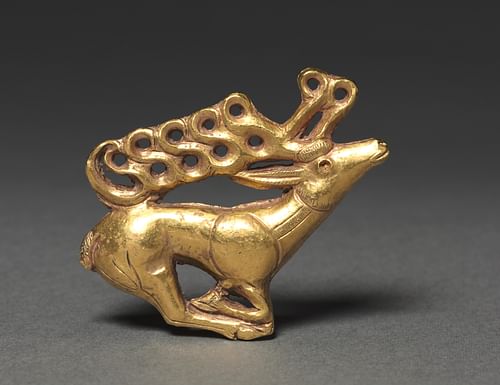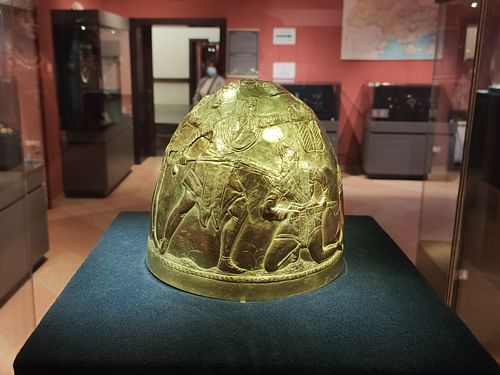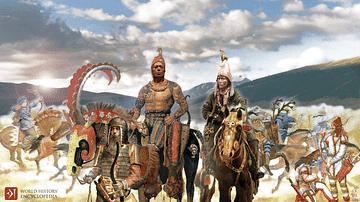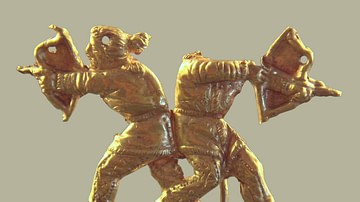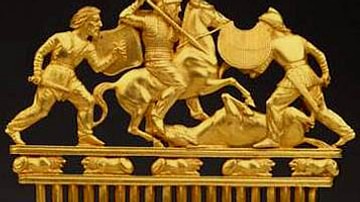Scythian women garnered leadership roles and a raised level of status in their day, which is perhaps without parallel until recent times. While many female figures rose to pivotal roles in history, their rise was not a reflection of systemic opportunity. Historically, women often led segregated, labor-filled lives, but for Scythian women, the historical and archaeological record indicates something different.

Scythian Origins & Territory
While there is much debate about Scythian origins, "Herodotus claims, and most modern scholars agree: they moved [west] from Asia into Europe by way of the great steppe corridor" (Alexeyev, 23). Yet, in the 1st century BCE, the Greek historian Diodorus Siculus states the first Scythians moved north from the Araxes River of Armenia to the northern Black Sea area. A modern traditional view is, they were "descendants from the Srubnaya culture who, between the middle of the 2nd millennium B.C. and the end of the 7th century B.C., moved [south] in several waves from the Volga-Ural steppes into the north Black Sea" (Melyukova, 99).
Writing in the 5th century BCE, Herodotus also shows the Sarmatians, splitting from the Black Sea Scythians, moving east. Then recent archaeological discovery at Tuva in the Altai mountains, which dates Scythian settlement to the 9th century BCE, suggests early origins in the east. Ultimately though, as 1st-century CE Chinese historians speak of their red hair and blue eyes, the Scythians' Caucasian features and Indo-European language support earlier Bronze Age origins in the west, likely from the Celts.
Often mentioned in ancient sources, Scythian ascendancy spanned between the 7th and 3rd centuries BCE, in areas around the Black and Caspian Seas. Covering an area 2500 miles (4000 km) in length, their territory ranged from Thrace in the west, across the steppe of Central Asia, to the Altai Mountains in the east. The open plains, desert, and forest-steppe expanses over which they ranged were conducive to herding animals and travel by horse rather than a settled way of life involving agricultural production. Living in covered wagons, the Scythians thus led a nomadic warrior way of life. Interestingly, a group of their women would live similarly, and their role as warriors was not just supportive; they, in fact, became rulers as well.

Amazons
When the warrior women, known to us today as the Amazons, first entered the historical record, they, according to Herodotus (c. 484- 425/413 BCE), came to Scythian territory as invaders of a sort. Mixing myth with legend, the Amazons were thought to be daughters of Ares, the god of war, and were portrayed to have fought against the heroes of Greek mythology such as Hercules, Theseus, and Bellerophon (though on the losing side).
While the telling of the Amazons finds its way into modern lore (Wonder Woman), the reality of their history has long been debated. It seems the Amazons also played an eminent role in the military and political life of their people. They even gained - as a group - social status equal to their men. Herodotus tells the story of a foreign race of warlike women coming to the shores of Scythia. Accordingly, after their defeat by the Greeks, the Amazons were rounded up onto three ships, but once at sea, the Amazons killed their guards. Knowing nothing about maritime navigation, they floated about the Sea of Azov at the mercy of winds and waves until they came to the shores of Scythia, where they raided and stole horses, which prompted war with Scythia.
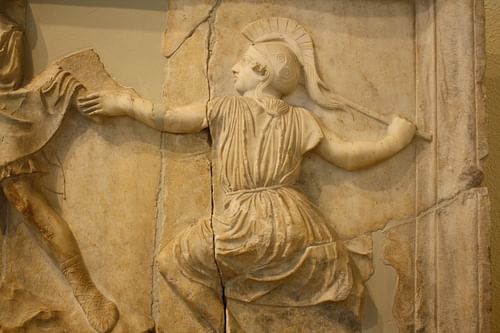
Herodotus gives no indication who won the conflict, but the Scythians must have been impressed enough with their war skill and bravery to want to incorporate them into their society and bloodline. Their strategy was to send a proportional number of young men with instructions to approach the Amazons, not fight, flee when pursued, and return to their camp nearby. The two bands, though they spoke different languages, eventually intermingled. However, when the young men later suggested they all settle down and go home, the Amazons refused, proposing instead a journey east to make their own tribe. Herodotus claims the Sarmatians were the result of this union and spoke a hybrid Scythian tongue. Moreover, these women warriors maintained their independence by following their ancient ways, often hunting on their own and warring alongside their men. They also forbade their daughters from marrying until they had killed a man in combat. (Histories, 4.110-117)
Scythian Women-Rulers
Whether Herodotus’ account is wholly or partly true, the 2nd-century CE historian Appian validates the sovereign/warrior status of Scythian women. When describing Pompey’s (106-48 BCE) Roman triumph for defeating Mithridates VI of Pontus (120-63 BCE), he includes among the procession of captured kings and generals "female rulers of Scythia" (Mithridatic Wars, 17.116-17). The fact Appian mentions female rulers, plural and contemporary, indicates a broad, shared, common, and cooperative status of rulership. Moreover, Herodotus’ reference of Tomyris, the Scythian warrior queen, defeating Cyrus the Great (r. c. 550-530 BCE) in battle centuries earlier, again suggests a tradition of female sovereignty (1.205-14). Additionally, about a closely related tribe "living on the Silk Route crossroads between the Altai regions and northwest China" (Mayor, 138), Herodotus also reports that "among the civilized and righteous Issedonians the women share power equally with their men" (4.26.2).
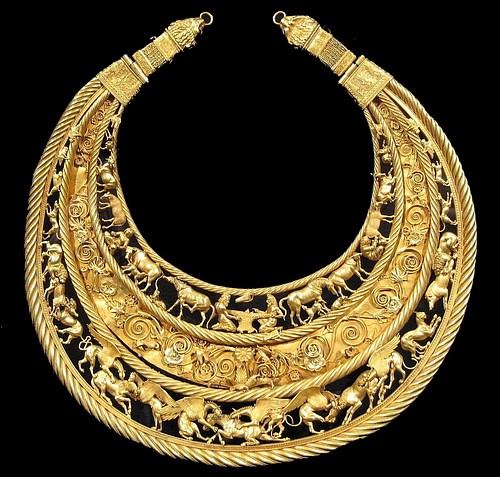
The archaeological evidence as well indicates broad warrior, if not sovereign status for Scythian women. In 1993, in the easternmost reaches of the Scythian confederation at Ak-Alakha on the Ukok plateau in the Altai mountains, excavators found a burial site of a rich Scythian female. She was the central figure at the site, buried with objects of status, surrounded by six saddled horses, which makes it likely she was a principal elite of her people. Finally, according to Barry Cunliffe, in Sarmatian territory, "one-fifth of the excavated warrior burials dating from the fifth to fourth centuries are female, while in Scythian territory more than forty female warrior burials are known" (187).
So while we have the exciting story of the legendary self-assertive Scythian warrior women of Scythia, what about the non-warrior regular working-class woman? Did they as a group also receive commensurate respect within their family unit and community? The structure of Scythian society certainly makes that a possibility.
Scythia’s Nomadic Social Structure
Scythia's governance at the top was mainly a form of shared power. While Herodotus refers to Scythian "kings" and some by name, the Scythian government was more a confederation of tribes and chiefs, a common form of social organization in Central Asia. Scythia’s tribal structure is disclosed in Herodotus’ account of the invasion of Scythia under Darius I of the Persian Achaemenid Empire (r. 522-486 BCE). Herodotus’ account reveals that while a high chief represented the Scythian nation in the messaging between notables, other subchiefs also voiced their opinion and had a significant say in implementing action.
When it comes to their social structure, besides the nomadic type, Herodotus mentions two other settled classes of Scythians: the "royal" and the "farming" kind. Nevertheless, as ancient sources attest and as their military organization indicates, the Scythians were primarily nomadic. More than one source mentions their houses on wheels, pulled by teams of oxen. Compared to the urban centers of the more socially stratified agricultural societies, the very nature of their lifestyle - nomadism by house-wagon - may have engendered for the Scythians a higher degree of shared purpose and a more open society. Though there were chiefs, as a nation, everyone lived similarly and moved simultaneously.
There were no grand palaces with high walls requiring a protocol of social separation for the elite. When they did settle, celebratory or ceremonial activity would have been events shared by all. Furthermore, while the excessive hoarding of wealth by a few would have a socially discordant effect on an interdependent community of people on the move, when it came to the everyday activity of animal husbandry, trade, crafts, hunting, and warfare, everyone’s contribution would have been visible and essential. For the non-warrior women, each wagon home would have been hers to run.
Scythian wagons could be richly and colorfully adorned, as the Scythians themselves were. Though one might think nomads on the move would have lived plainly, archaeological discovery reveals something extraordinarily different. On equal and prolific display, Scythian women shared with their men sophisticated tastes in art and fashion.
The Coequality of Scythian Fashion & Art
Much of what is learned about Scythian culture comes from recent finds from burial mounds (kurgans) north of the Black Sea and in the Altai region of Mongolia. While ancient written sources focus on their nomadic warlike character, Scythian burial goods add another layer of understanding to their remarkable cultural sophistication and social vibrancy. Besides their intricate craftsmanship in glittering gold, many Scythian artifacts tell a life story. And so, a comb is not just a comb but is crafted to show scenes from Scythian warfare in fierce combat, or a pectoral shows scenes from daily life: the milking of a ewe, two men sewing a shirt, calf and colts nursing.
The Black Sea artifacts offer dramatic snapshots of Scythian fashion, interests, beliefs, habits, and daily life visuals like few burial goods do. Many, like the pectoral pictured above, have prey/predator themes. Other common themes are recumbent cats and reclining stags, either remarkably accurately portrayed or uniquely stylized.
Equal to their imaginative taste in gold, "the frozen tombs of the Altai provide an incomparable vision of the sheer exuberance of nomad dress: the love of bright, contrasting colors and intricate decorations formed by stitching, embroidery, and the attachment of leather cut-outs" (Cunliffe, 207). Such products were enjoyed by males and females alike. Characteristic of Scythian burials is that they include female companions and principals. Of the five burials at the Pazyryk site, "each tomb consisted of a log-built chamber containing log coffins, usually with a man and women inside" (Stepanova, 98). At this and other Altai sites, colorful rugs and textiles of varietal weaves and ornament, using green, blue, yellow, red, and orange dyes were found with the human remains. Additional finds include a plethora of items reflecting a parity of fashion statements. Besides practical objects such as combs and mirrors, presumably used by both sexes, were multiple gold-plaque animals in the Scythian abstract style.
Necklaces of colored stone and glass beads and a number of gold earrings with granulated pendants were also found. At the site called Pazyryk-2, a pair of gold earrings, with dangling cloisonné-like sections, was worn by a woman who had both ears pierced. Men found in the same complex had their left lobe pierced. Moreover, as part of the Scythian dress, felt stockings were popular for both sexes. "Stockings for the women were ornamented with the appliqué of lotus palmettes joined in a garland; men’s stockings had heart-shaped figures" (Stepanova, 127). Headdresses could be highly decorated; one belonging to a chief consisted of a 14-inch-high (34.5 cm) mythic eagle holding the head of a deer in its beak, but the 16-inch-tall (40 cm) ladies headdress found nearby would have attracted similar attention. Such headdresses found at Scythian sites in the Altai Mountains (worn over a shaved head, with the ladies’ topknot pulled through the top) were typically crested with silhouettes of deer. They were additionally decorated with figures of birds, frame-rods, and hairpins of gold-leafed deer. Such exaggerated adornment would obviously have brought conspicuous attention to the wearers.
As important as their fashionable dress, tattoos also held broad appeal for both sexes. Tattoo connoisseurs today would appreciate the Scythian penchant for tattoos of abstract images of curled cats, stags, rams, antelope, goats, and mythic creatures. While the body of a male principal at Pazyrk had legs, chest, back, and shoulder-to-hand tattoos of animals in the Scythian fashion, a female principal, popularly known as the Siberian Princess, also had tattoos of similar design and coverage. Just as tattoos today are meant to be shown and appreciated, Scythian tattoos also reflect a level of mutual appreciation.
Conclusion
In the study of Scythian women, when it comes to the ordinary person, we know little. The fantastic kurgan finds are of the Scythian elite, while the ancient sources mostly tell of their war machine. Yet a comparison of their social structure to recent nomadic people supports the assumption of an inclination for social equivalence. Adrienne Mayor aptly states:
Companionable relationships characterized by equality and a sense of interdependence are traditional and practical ways of life in many nomadic and semi-nomadic cultures. While the ancient Nart sagas of the Caucasus allude to the shared authority, responsibility, interdependence, love and affection between males and females, early modern European travelers in the Caucasus remarked on the great freedom and respect accorded to women. Moreover, "easy camaraderie" and "blurred lines between sex roles" are phrases used to describe the egalitarian lifestyle of some nomads living today in Kazakhstan and other ancient Scythian lands. (138-39)
Thus, when it comes to female status, Scythia’s history indeed offers a tantalizing story of a group of women who garnered for themselves a more equal place of contribution. As the Scythian nomadic social structure engendered equality, women warred right alongside their men, while others were sovereigns in their own right. Moreover, the vibrancy and sophistication of Scythian art appear matched by a shared sophistication of taste. For non-warring women, the equal access, use, and display of dress and adornment by both sexes found at the kurgans portray a mutual appreciation of products and persons. While mutual respect at higher levels suggests common mirroring, known nomadic proclivity for broad social parity in modern times suggests a degree of general respect in ancient times. Either way, when it comes to female assertiveness, the story of Scythian women holds a unique place in ancient history.


